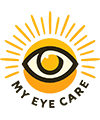The functioning of the eye
The eye captures light rays and converts them into signals to the brain. For a good sharp image, the light rays must be bent (refracted) so that they coincide exactly at one point: the retina at the back of your eye. The refraction happens first through the cornea and the fine tuning then through your natural lens.
You can compare the eye with a photo camera: by adjusting the lens you ensure that the incoming rays are bent in such a way that they converge exactly on the film. Your photo will then become sharp. Is the strength of your cornea and lens out of proportion to the length of the eyeball? Then there is a refractive error. You will see objects in the distance out of focus. You will then need glasses, contact lenses or refractive eye surgery to see clearly.
The anatomy of the eye
Everyone prepares for an operation differently. Some want to know as much as possible. Others limit themselves to the main points. Do you belong to the first group? Then you can read everything about the anatomy of the eye here.
Eye muscles. These run from the back of the eye socket to the eyeball. The four rectus muscles ensure the horizontal and vertical movements of the eye. The two oblique muscles for rotation.
Hard sclera. This is the outer layer to which the eye muscles are attached. It gives the eye strength and protects the inner layers. At the front, the sclera transitions into the cornea.
Choroid (choroid). This is located on the inside of the sclera. The choroid is the most vascularized part of the eye and supplies the retina with nutrients and oxygen. It merges into the ciliary body and iris at the front.
Retina (retina). This is the light-sensitive layer that covers the choroid on the inside. The light-sensitive cells, called rods and cones, connect to the brain through nerve fibers in the optic nerve.
Optic nerve. The images that appear on the retina are conducted to the brain by the optic nerve. The images are interpreted in the brain.
Blind spot (papilla). The place where the nerve fibers leave the eye via the optic nerve. The papilla is also called a ‘blind spot’ because there are no light-sensitive retinal cells here. We cannot see images with the papilla either.
Yellow spot (macula). Small area in the center of the retina, close to the papilla, also called the ‘yellow spot’. The macula has by far the largest concentration of light-sensitive cells and is the most sensitive part of the retina. The sharpest details can only be seen through this area. This is also the only place where we can distinguish colors.
Capillaries in the retina. Provide the retina with oxygen and nutrients.
Vitreous body (vitreous humor). Gelatinous substance, surrounded by a thin membrane, which fills the central cavity of the eye.
Jet body. Thickening of the choroid in which there is a sphincter muscle that provides accommodation for the lens of the eye. The ‘aqueous humor’ production also takes place here.
Supportive fibers. Connect the jet body to the lens. By tightening the sphincter muscle, the fibers relax and the lens becomes more convex (accommodation). This makes the lens refract the light more strongly and you can see better up close.
Space between the cornea and iris (anterior chamber). The anterior chamber is filled with aqueous humor, which is continuously produced by the ciliary body. This keeps the eye on tension.
Pupil. This dark opening in the center of the iris will narrow in bright light and widen in the dark.
Iris. The colored part behind the cornea with the pupil in the center. Eye color is determined by the number of pigment cells in the iris. Brown eyes contain many pigment cells, blue eyes have few.
Cornea. The transparent layer over the front of the eye. This is the first refractive surface of light rays at distant objects. Two-thirds of the eye’s refractive lens power comes from the cornea.
Conjunctiva (conjunctiva). The conjunctiva protects the eye against external influences. It plays an important role in optimal lubrication of the eye.
Lens. The second important refractive surface. At a young age, the lens is flexible enough for accommodation. As we age, the lens becomes more rigid and the ability to accommodate decreases. The result is presbyopia, which requires reading glasses.


